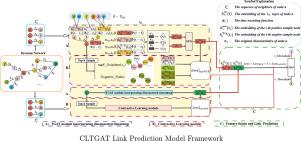Temporal graph attention and contrastive learning model for link prediction in dynamic networks
IF 4.6
2区 计算机科学
Q1 COMPUTER SCIENCE, HARDWARE & ARCHITECTURE
引用次数: 0
Abstract
Existing discrete time-slicing methods suffer from three critical limitations: coarse temporal processing granularity, exclusively model connection establishment events while neglecting the impact of disconnection events, and vulnerability to sample imbalance and transient connection noise. These limitations severely constrain adaptability in dynamic networks characterized by connection instability and interaction volatility, where both connection establishment and disconnection events govern topological evolution. To address these challenges, this paper proposes a novel dynamic link prediction framework integrating Contrastive Learning with enhanced Temporal Graph Attention Network (CLTGAT). Our model employs continuous timestamp encoding to explicitly incorporate connection moments while fusing disconnection moments via weighted mechanisms. This dual-event modelling enables joint influence of connection/disconnection timestamps on link states. Crucially, we design a connection-duration-based Top-K contrastive sampling strategy to simultaneously mitigate transient connection noise and sample imbalance, selecting stable neighbours as positive samples while controlling distribution to alleviate prediction bias. Evaluations on three highly volatile real-world dynamic network datasets, viz., Infocom05, Hyccups and Infocom06, demonstrate CLTGAT’s superiority. Compared with seven other methods, our approach achieves higher link prediction accuracy with reduced training time, exhibiting enhanced adaptability to rapidly evolving network scenarios.

动态网络中链接预测的时间图注意和对比学习模型
现有的离散时间切片方法存在三个严重的局限性:时间处理粒度粗,只模拟连接建立事件而忽略断开事件的影响,易受样本不平衡和瞬态连接噪声的影响。这些限制严重限制了以连接不稳定和交互波动为特征的动态网络的适应性,其中连接建立和断开事件控制着拓扑进化。为了解决这些问题,本文提出了一种结合对比学习和增强时间图注意网络(CLTGAT)的动态链接预测框架。我们的模型采用连续时间戳编码来显式地合并连接矩,同时通过加权机制融合断开矩。这种双事件建模支持连接/断开时间戳对链路状态的联合影响。关键是,我们设计了一个基于连接持续时间的Top-K对比采样策略,以同时减轻瞬态连接噪声和样本不平衡,选择稳定的邻居作为正样本,同时控制分布以减轻预测偏差。通过对Infocom05、Hyccups和Infocom06这三个高度不稳定的真实动态网络数据集的评估,证明了CLTGAT的优越性。与其他7种方法相比,该方法在减少训练时间的同时实现了更高的链路预测精度,对快速变化的网络场景表现出更强的适应性。
本文章由计算机程序翻译,如有差异,请以英文原文为准。
求助全文
约1分钟内获得全文
求助全文
来源期刊

Computer Networks
工程技术-电信学
CiteScore
10.80
自引率
3.60%
发文量
434
审稿时长
8.6 months
期刊介绍:
Computer Networks is an international, archival journal providing a publication vehicle for complete coverage of all topics of interest to those involved in the computer communications networking area. The audience includes researchers, managers and operators of networks as well as designers and implementors. The Editorial Board will consider any material for publication that is of interest to those groups.
 求助内容:
求助内容: 应助结果提醒方式:
应助结果提醒方式:


